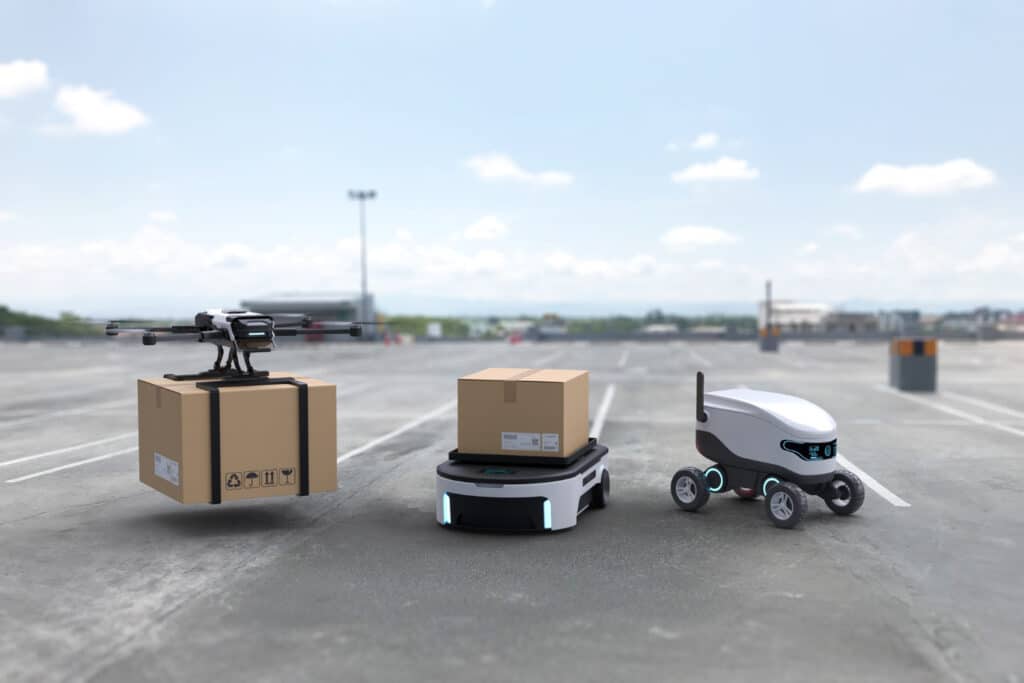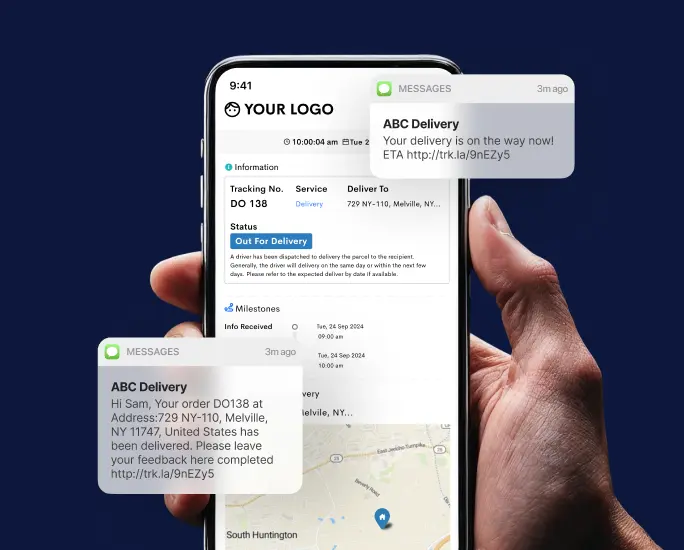The future of last-mile delivery is changing fast due to technological advancements and the need for better delivery services. One area gaining a lot of attention is autonomous delivery vehicles.
These vehicles can transform how goods are delivered from distribution centers to our homes. They promise improved efficiency, lower costs, and more sustainable delivery.
This blog will explore autonomous delivery vehicles, their benefits, and their challenges in becoming widely used. Let’s dive into this exciting frontier and discover the potential of last-mile delivery.
Types of Autonomous Delivery Vehicles
Ground-based autonomous vehicles
Ground-based autonomous vehicles include various types of vehicles that operate on the ground without human intervention.
Self-driving cars are one prominent example of ground-based autonomous vehicles.
These vehicles have advanced sensors, such as lidar, radar, and cameras, to perceive their surroundings and make real-time navigation, speed, and route selection decisions.
They can transport passengers or goods from one location to another without the need for human drivers.
Aerial autonomous vehicles
Aerial autonomous vehicles, also known as unmanned aerial vehicles (UAVs) or drones, are designed to operate in the airspace without a human pilot. Delivery drones are a prominent example of autonomous aerial vehicles.
They can carry small packages or goods and deliver them to specific locations. Delivery drones have navigation systems, sensors, and cameras to ensure precise flight control, obstacle avoidance, and accurate delivery.
They are commonly used for last-mile delivery, especially in areas with limited ground access or challenging terrain.
Maritime autonomous vehicles
Maritime autonomous vehicles are autonomous vehicles that operate on water bodies, such as oceans, rivers, or lakes. These vehicles include autonomous boats, ships, or underwater drones.
Maritime autonomous vehicles are utilized in various applications, including ocean exploration, surveillance, underwater mapping, and environmental monitoring.
They are equipped with specialized sensors, navigation systems, and communication technologies to operate autonomously while adhering to maritime regulations and ensuring safety at sea.

Advantages of Autonomous Delivery Vehicles
Increased efficiency and productivity
Autonomous delivery vehicles can significantly enhance efficiency and productivity in the logistics industry.
Unlike human drivers who are subject to fatigue, breaks, and limited working hours, autonomous vehicles can operate continuously, optimizing delivery routes and schedules for maximum efficiency.
They can leverage real-time data, such as traffic conditions, weather updates, and customer preferences, to make intelligent decisions on the most efficient paths to take and the optimal order of deliveries.
This level of optimization can reduce overall delivery times, increase the number of deliveries made per day, and improve customer satisfaction.
Enhanced safety and reduced accidents
One of the most significant advantages of autonomous deliveries is the potential to enhance safety on the roads. Human errors, distractions, and fatigue are leading causes of accidents in the transportation industry.
Autonomous vehicles, equipped with advanced sensor systems, can constantly monitor their surroundings, accurately detect obstacles, and make split-second decisions to avoid collisions.
With their ability to react faster and more precisely than human drivers, autonomous vehicles can help prevent accidents caused by factors such as sudden lane changes, improper signaling, or failure to yield the right of way.
Cost-effectiveness and potential savings
Adopting autonomous delivery can lead to significant cost savings for businesses. One of the primary areas of cost reduction is labor expenses. Human drivers require wages, benefits, and training, whereas autonomous vehicles eliminate the need for a human driver altogether.
This reduction in labor costs can be substantial, especially for companies with large fleets of delivery vehicles.
Additionally, autonomous vehicles can be programmed to optimize fuel efficiency by considering factors such as speed, acceleration, and idling time.
Environmental impact and sustainability
Autonomous deliveries have the potential to make a positive impact on the environment and contribute to long-term sustainability.
Firstly, autonomous vehicles can be designed to run on electric power, reducing or eliminating greenhouse gas emissions and air pollution associated with traditional fossil fuel-powered delivery vehicles.
Electric autonomous vehicles are more energy-efficient and produce zero tailpipe emissions, which helps combat climate change and improve air quality, especially in urban areas.
Moreover, autonomous vehicles can optimize delivery routes, reducing unnecessary mileage and minimizing traffic congestion.
Use Cases of Autonomous Delivery Vehicles
Retail and e-commerce deliveries
Autonomous delivery vehicles offer significant benefits to the retail and e-commerce sectors. They can efficiently transport packages from distribution centers or warehouses to customers’ homes.
With autonomous vehicles, companies can reduce their reliance on human drivers and potentially operate delivery services round the clock. These vehicles can navigate through traffic, follow optimized routes, and leverage real-time data to ensure prompt and efficient deliveries.
Food and grocery deliveries
Autonomous vehicles have become increasingly popular for food and grocery deliveries. Restaurants, meal delivery services, and grocery stores can leverage autonomous delivery vehicles to transport prepared meals, groceries, and other food items directly to customers’ doorsteps.
These vehicles can maintain food quality and temperature control, ensuring that perishable items reach customers in optimal condition.
With autonomous vehicles, companies can streamline their delivery operations, reduce delivery times, and offer more convenient services to customers who prefer home delivery for their meals or groceries.
Medical and healthcare deliveries
The healthcare industry can benefit significantly from autonomous delivery. These vehicles can transport medical supplies, medications, and lab samples between hospitals, clinics, and pharmacies.
With autonomous vehicles, medical facilities can ensure timely delivery of critical supplies, enabling better patient care and faster diagnosis. They can also support emergency situations where immediate delivery is essential.
Postal and package deliveries
Autonomous delivery vehicles have the potential to revolutionize postal and package delivery services. These vehicles can handle the transportation of letters, parcels, and packages from postal facilities to designated addresses.
By leveraging autonomous technology, companies can optimize delivery routes, increase the speed of deliveries, and potentially offer 24/7 delivery services.
Challenges and Limitations of Autonomous Delivery Vehicles
Technical Limitations and Reliability Concerns
- Navigation and Obstacle Detection: Autonomous delivery vehicles rely on advanced sensors and software to navigate safely and detect obstacles. However, they may face challenges in accurately perceiving complex traffic situations, unpredictable human behavior, and adverse weather conditions.
- Technical Malfunctions: Like any technology, autonomous vehicles can experience technical failures or malfunctions. These issues can range from software glitches to sensor failures, which could compromise the vehicle’s ability to operate safely and efficiently.
Public Acceptance and Trust
- Safety Concerns: Despite advancements in autonomous vehicle technology, concerns about safety remain. High-profile accidents involving autonomous vehicles can lead to public skepticism and mistrust, hindering widespread acceptance of autonomous delivery vehicles.
- Human Interaction: Interactions between autonomous vehicles and human drivers, pedestrians, and cyclists can be complex. Establishing clear communication and understanding between autonomous vehicles and other road users is crucial for their acceptance and integration into existing transportation systems.
Job Displacement and Socio-Economic Impact
- Employment Impact: Autonomous delivery vehicles have the potential to disrupt the job market by replacing human drivers and delivery personnel. This could result in job losses and require workforce retraining or job transitions.
- Economic Implications: The widespread adoption of autonomous delivery vehicles could impact various industries, such as logistics and transportation. While it may lead to cost savings and increased efficiency, it can also disrupt existing business models and have socio-economic implications for workers in these industries.
The Future of Deliveries with Autonomous Delivery Vehicles
In conclusion, the future of deliveries is promising with autonomous delivery vehicles. These vehicles offer increased efficiency, enhanced safety, cost-effectiveness, and reduced environmental impact.
By optimizing routes and schedules, autonomous vehicles improve productivity and meet customer demands more effectively. They also enhance road safety by mitigating human errors and fatigue.
Moreover, businesses can save on labor and fuel costs, while contributing to sustainability by reducing emissions.
However, challenges such as job displacement and regulatory frameworks need to be addressed. With collaborative efforts, autonomous delivery vehicles have the potential to transform the logistics industry.










